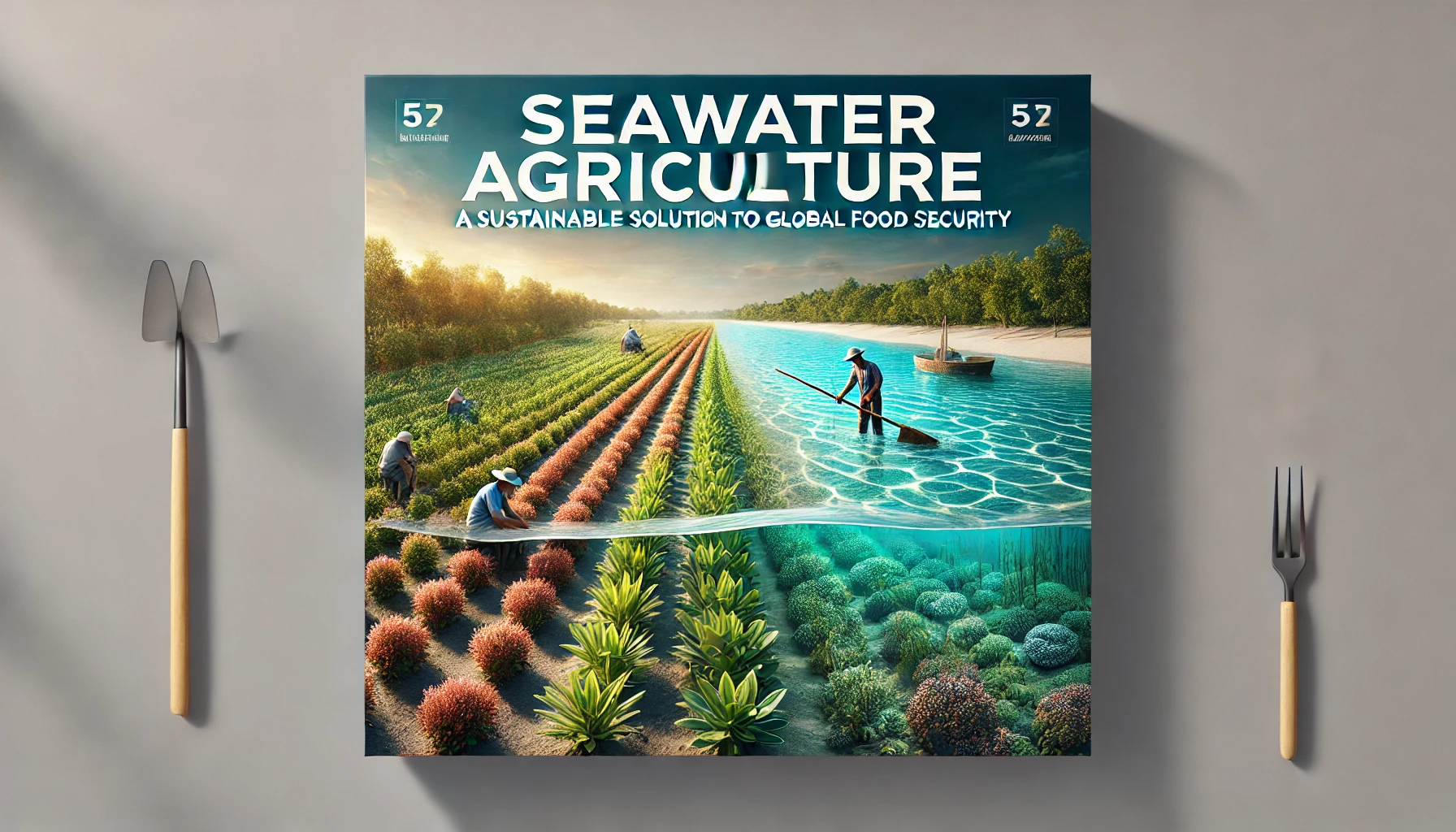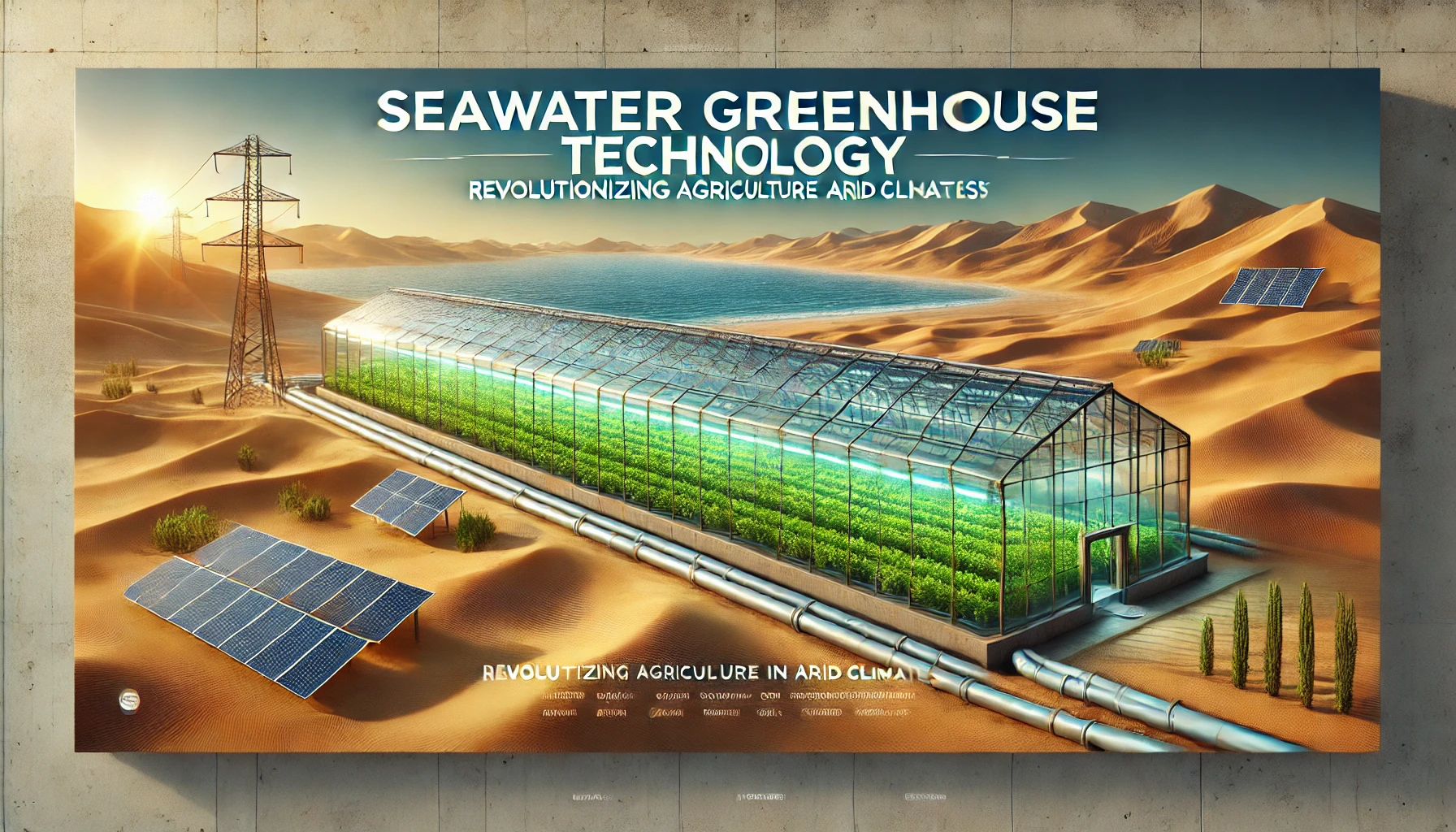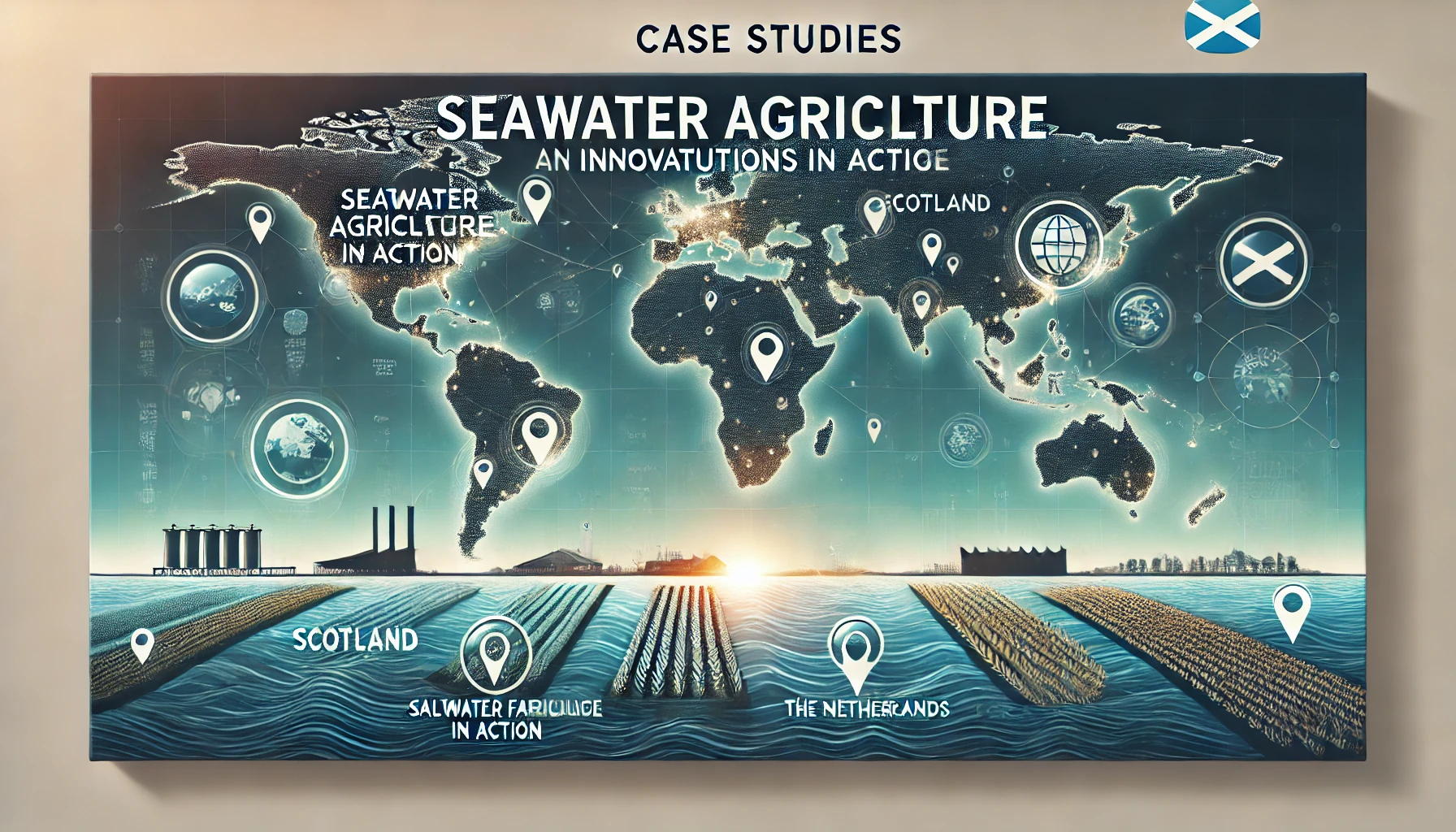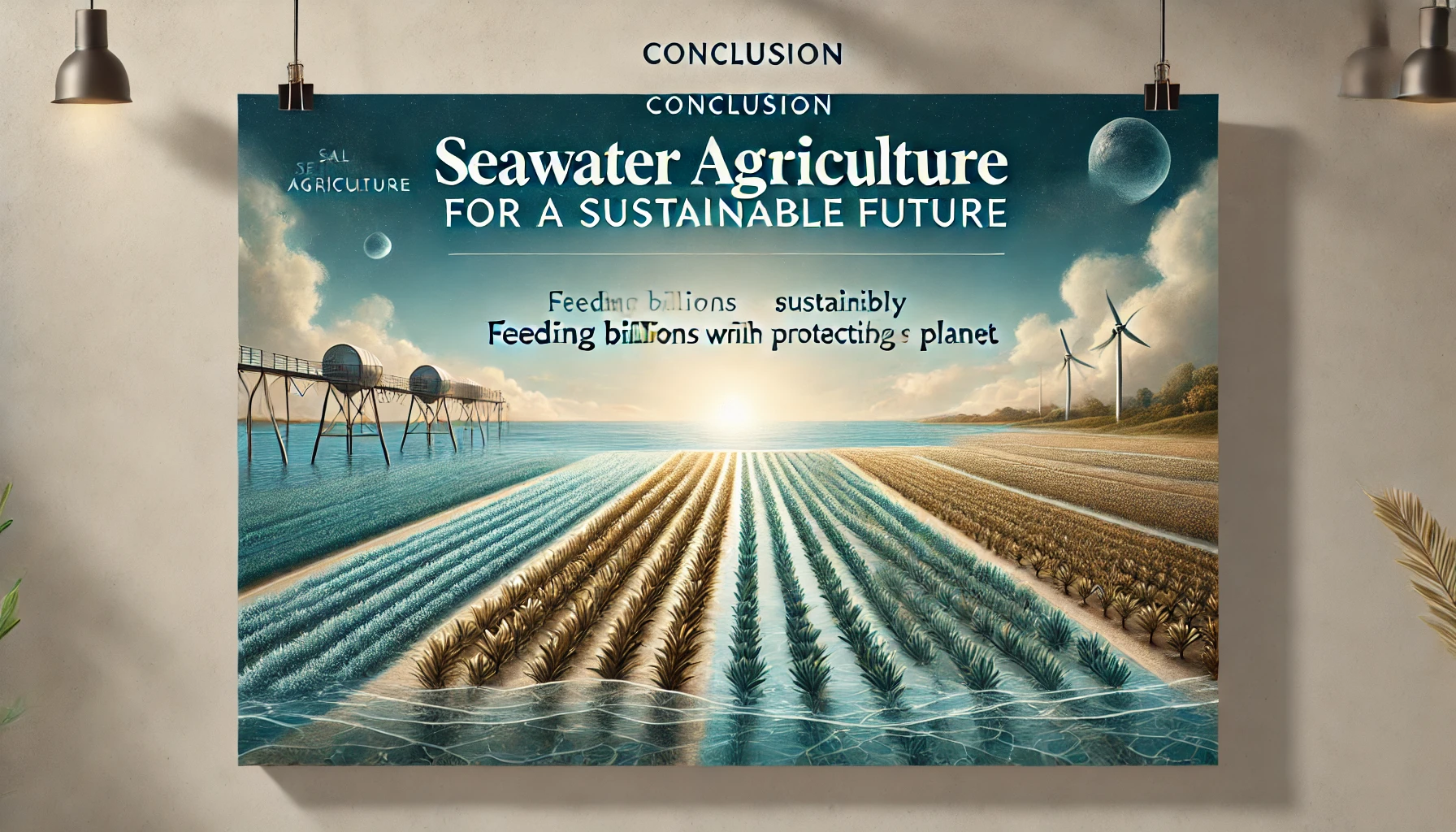
As the world faces the growing challenge of food security and dwindling freshwater resources, seawater agriculture is emerging as a promising solution. This innovative approach harnesses the power of seawater and salt-tolerant crops to produce food while preserving vital freshwater reserves. In the coming decades, seawater agriculture could revolutionize the agricultural sector, providing a sustainable way to feed the global population and mitigate the impacts of climate change.
What is Seawater Agriculture?
Seawater agriculture refers to the practice of using seawater or saline water sources to grow crops. This can be done either directly or through desalination techniques, allowing agriculture to thrive in regions with limited access to freshwater. The focus of seawater agriculture is on salt-tolerant crops that can endure the high salt concentrations found in seawater.
This form of agriculture is particularly valuable in arid and semi-arid regions where fresh water is scarce. It can provide a way to grow food without relying on the increasingly limited freshwater resources. Additionally, seawater agriculture can contribute to mitigating climate change by utilizing salt marshes and other coastal ecosystems that sequester carbon and protect against flooding and soil erosion.
Benefits of Seawater Agriculture
Seawater agriculture holds immense potential in addressing the food security crisis facing the world today. The key benefits of this innovative practice include:
-
Increased Food Production: Seawater agriculture has the potential to increase global food production by up to 70% over the next 30 years. By incorporating seawater irrigation, more land can be utilized for food production, especially in coastal areas that are otherwise unsuitable for traditional agriculture.
-
Freshwater Conservation: With many regions already experiencing freshwater scarcity, seawater farming provides an alternative that reduces reliance on freshwater for crop irrigation. This can help conserve water resources, ensuring they are available for other essential uses.
-
Carbon Capture Potential: Coastal ecosystems such as salt marshes can absorb carbon dioxide at rates much higher than traditional forests, potentially playing a crucial role in combating climate change. By integrating seawater agriculture with these ecosystems, we can enhance both food production and carbon capture.
-
Environmental Sustainability: Seawater farming has the potential to help reduce greenhouse gas emissions by promoting sustainable practices. Unlike traditional agriculture, which often involves significant land degradation and water wastage, seawater agriculture uses resources efficiently, minimizing environmental impact.
Salt-Tolerant Crops: The Key to Seawater Agriculture
One of the most exciting aspects of seawater agriculture is the ability to grow salt-tolerant crops. These crops, known as halophytes, are specifically adapted to thrive in salty environments. Halophytes can be used for various purposes, including food production, biofuels, and animal fodder.
Some examples of salt-tolerant crops include:
-
Halophytes: These are naturally occurring salt-loving plants that can be consumed directly or used in various industries, such as cosmetics and biofuels.
-
Potatoes, Cabbages, and Tomatoes: Researchers have found that certain varieties of traditional crops, such as potatoes, cabbage, tomatoes, and carrots, can tolerate higher salt concentrations than previously believed.
-
Barley and Oats: Certain grains like barley and oats have shown resilience in brackish water irrigation, making them viable options for regions with saline groundwater.
-
Beetroots and Strawberries: Interestingly, some fruits, like strawberries, also show an ability to grow in saltier environments, offering more options for cultivation in saline areas.
While some crops like lettuce, chard, and chicory are negatively affected by high salt concentrations, saltwater irrigation can still be used in a controlled manner to mitigate the impacts of salinity on growth.
Seawater Greenhouse Technology: Revolutionizing Agriculture in Arid Climates

Seawater greenhouses are a groundbreaking innovation that uses seawater to create an optimal growing environment for crops in arid and desert climates. The technology works by utilizing the natural processes of evaporation and condensation to cool the greenhouse and create a humid environment that is ideal for plant growth.
Here’s how seawater greenhouses work:
-
Evaporation: Seawater is evaporated, creating a cool, humid air that is passed into the greenhouse.
-
Condensation: As the humid air meets cooler surfaces inside the greenhouse, it condenses, providing fresh water for irrigation.
-
Ideal Growing Conditions: The increased humidity and reduced temperatures make the greenhouse environment more suitable for growing a variety of crops, including salt-tolerant varieties.
Seawater greenhouses can be used to grow traditional crops such as tomatoes, cucumbers, and herbs, alongside salt-tolerant crops. This technology is already being implemented in regions like the Canary Islands and the Middle East, where water scarcity is a significant challenge.
The Global Need for Seawater Agriculture
As the global population continues to grow, so does the demand for food. Traditional farming methods, however, are under increasing pressure due to limited freshwater resources, soil degradation, and the impacts of climate change. This has led to a dire need for more sustainable farming methods that can meet the food demand without further exhausting precious resources. Seawater agriculture offers a solution by utilizing salt-tolerant crops and seawater to create more efficient farming practices.
Growing Global Water Scarcity
Freshwater scarcity is a critical issue affecting more than 2 billion people worldwide. Many regions, especially those in arid and semi-arid zones, are experiencing increased salinity in water sources. This makes traditional agricultural practices increasingly unsustainable. Seawater farming can reduce the pressure on freshwater resources, offering an alternative irrigation method that uses saline water effectively. By tapping into abundant seawater, which covers around 70% of the Earth’s surface, seawater agriculture can help alleviate some of the challenges posed by limited freshwater.
How Seawater Agriculture Works: Key Techniques
Seawater agriculture involves several techniques designed to maximize the benefits of saline environments for farming. These methods enable the growth of a variety of crops and vegetables, while also conserving freshwater resources and maintaining healthy ecosystems.
Seawater Irrigation: A Sustainable Alternative
Seawater irrigation involves using saline or brackish water to irrigate crops. While traditional crops cannot survive in high salinity, many salt-tolerant plants can thrive in such environments. Saline water is used in conjunction with careful soil management techniques to ensure that salt does not accumulate to levels that harm the crops. These methods can be adapted for large-scale agriculture, especially in coastal regions where seawater is readily available.
Some of the most common crops grown using seawater irrigation include:
-
Halophytes (salt-loving plants)
-
Tomatoes
-
Cabbages
-
Beetroots
-
Carrots
-
Barley
By utilizing salt-tolerant crops and seawater irrigation, farmers can boost food production while conserving precious freshwater.
Seawater Greenhouses: Harnessing the Power of Evaporation
Seawater greenhouses use the natural processes of evaporation and condensation to create a more favorable environment for plant growth, especially in arid climates. Seawater is evaporated, creating humidity, which cools the greenhouse and enhances crop yields in regions with hot temperatures. This method is particularly useful for areas such as the Middle East, where temperatures regularly exceed 40°C (104°F).
How Seawater Greenhouses Work:
-
Evaporation: Seawater evaporates due to the heat from the sun, creating humid air.
-
Condensation: The humid air meets cooler surfaces, where it condenses into fresh water.
-
Cooling Effect: The increased humidity and reduced temperature within the greenhouse help reduce water loss through evaporation from the crops, allowing for more efficient water use.
This innovative approach is already being used in countries like Israel and Spain, where saltwater farming practices have been proven to boost crop productivity while conserving water.
Saltwater Desalination for Crop Irrigation
While seawater is abundant, its salt content can pose challenges for irrigation. Desalination technologies are used to remove the salt from seawater, making it suitable for crop irrigation. However, desalination can be energy-intensive and costly. Nevertheless, ongoing advancements in reverse osmosis and other desalination technologies are making this process more efficient and affordable. By desalinating seawater, regions with limited access to freshwater can still ensure a reliable supply for agricultural use.
Case Studies: Seawater Agriculture in Action

Across the globe, there are several successful examples of seawater agriculture that highlight its potential to meet the growing demand for food.
Seawater Solutions in Scotland
Seawater Solutions, a startup based in Glasgow, is using seawater to grow vegetables in a region that is traditionally not associated with saltwater farming. The company’s innovative methods focus on integrating seawater irrigation and desalination techniques to enhance crop yields, even in Scotland’s cooler climate. Through these efforts, the company is showing that seawater agriculture is not limited to warmer, arid regions but can be applied in diverse climates.
Salt Farm Foundation in the Netherlands
The Salt Farm Foundation, located in the Netherlands, has been at the forefront of research on salt-tolerant crops. The foundation has demonstrated that conventional crops like potatoes and cabbages can tolerate higher levels of salinity than previously thought. This breakthrough is paving the way for expanding seawater farming practices to regions with higher soil salinity and limited fresh water.
GreenWave’s Global Network
GreenWave, a non-profit organization, works with farmers around the globe to promote regenerative ocean farming techniques. They use sea vegetables and saltwater to produce food and sea plant animal fodder, with a focus on sustainability. The organization’s model not only offers an alternative to traditional farming but also helps to restore marine ecosystems, protect coastal areas, and sequester carbon.
The Role of Seawater Agriculture in Addressing Climate Change
As climate change accelerates, seawater agriculture has a crucial role to play in mitigating the effects of the climate crisis. Rising sea levels, increased salinity in water sources, and extreme weather events are all predicted to worsen in the coming decades. By harnessing salt-tolerant crops and seawater for irrigation, this form of agriculture can help reduce the impact of climate change on food production.
Carbon Capture through Salt Marshes
Coastal ecosystems like salt marshes not only support biodiversity but also act as carbon sinks, capturing and storing carbon at levels much higher than terrestrial forests. These ecosystems are vital in the fight against climate change. Seawater agriculture integrated with salt marshes can help sequester carbon and reduce atmospheric CO2 levels.
Reducing Agricultural Emissions
Traditional agriculture is responsible for a significant portion of global greenhouse gas emissions due to practices like tilling, the use of fertilizers, and livestock farming. Seawater farming offers a more sustainable alternative by minimizing water use, reducing the need for chemical fertilizers, and preserving ecosystems. This transition can significantly reduce agriculture’s carbon footprint, contributing to global efforts to fight climate change.
Challenges and Solutions in Scaling Seawater Agriculture
While seawater agriculture holds immense potential, several challenges remain in its widespread adoption. The key hurdles include:
-
Soil Salinity Management: High salt concentrations can lead to soil degradation, making it essential to monitor and manage salt levels in the soil.
-
Economic Viability: While seawater farming has the potential to be economically viable, the high initial costs of technology such as desalination systems and seawater greenhouses may deter small-scale farmers.
-
Farmer Training and Adoption: Educating farmers on the benefits of brackish water irrigation and the importance of salt tolerance in crops is crucial to driving adoption of seawater agriculture.
Overcoming Soil Degradation
One promising solution to soil salinity is the use of salt-tolerant plants that can thrive in saline conditions without degrading the soil. Additionally, salt leaching techniques can be employed to reduce the accumulation of salt in the soil, ensuring that the land remains fertile for future crops.
Financial Support and Policy Incentives
To overcome the economic barriers, governments and organizations must provide financial support and policy incentives for farmers to adopt seawater agriculture. Offering subsidies for seawater desalination technologies and salt-tolerant crops can make these solutions more accessible, especially in regions most affected by water scarcity.
The Future of Seawater Agriculture
As the world grapples with increasing water scarcity, climate change, and the growing demand for food, seawater agriculture represents a critical tool in ensuring global food security. With continued investment in research, technology, and education, seawater farming can become a viable, sustainable, and scalable solution to feeding the world’s population in the coming decades.
Seawater agriculture’s potential is immense. By embracing salt-tolerant crops, innovative seawater greenhouses, and desalination technologies, we can transform agriculture into a more sustainable, resilient, and environmentally friendly practice. This approach not only addresses food security but also plays a pivotal role in combating the impacts of climate change and preserving precious freshwater resources for future generations.
Growing Crops with Seawater: Practical Considerations
Using seawater irrigation for crop production offers several practical advantages, including reducing the reliance on freshwater and improving water use efficiency. However, it is important to consider the soil salinity levels, as high concentrations of salt can negatively impact plant growth and soil quality.
Key Considerations for Seawater Irrigation:
-
Soil Salinity Management: Over time, high concentrations of salt in the soil can lead to soil degradation. It is crucial to monitor salt levels and implement measures such as leaching or the use of salt-tolerant crops to maintain soil health.
-
Seawater Desalination: In some cases, seawater may need to be desalinated to ensure that the salt concentration is low enough for irrigation. Desalination technologies, though energy-intensive, can provide a reliable source of freshwater for irrigation in regions where seawater is the only available water source.
Overcoming Challenges in Seawater Agriculture
While the potential of seawater farming is immense, several challenges must be addressed for this practice to scale globally:
-
Farmer Education and Buy-in: Convincing farmers and local communities to adopt brackish water irrigation can be challenging due to concerns about soil degradation and crop yields.
-
High Initial Costs: Implementing seawater agriculture requires significant upfront investment in infrastructure such as desalination systems and seawater greenhouses.
-
Climate Change Impacts: As climate change exacerbates water scarcity in many regions, the agricultural sector must adapt to new realities, such as rising salt concentrations in water sources and changing rainfall patterns.
Successful Seawater Agriculture Projects
Several innovative projects are already demonstrating the viability of seawater agriculture in different parts of the world:
-
Seawater Solutions: This Glasgow-based startup is using seawater to grow a variety of vegetables in Scotland, proving that even cooler climates can benefit from seawater irrigation.
-
Salt Farm Foundation: In the Netherlands, the Salt Farm Foundation has shown that conventional crops such as potatoes and cabbages can withstand higher salt levels, opening up new possibilities for growing food in coastal regions.
-
GreenWave: A global network of farmers, GreenWave uses regenerative ocean farming practices to grow sea vegetables and other crops using seawater, demonstrating the potential for sea plant animal fodder and sustainable food production.
Measuring Success in Seawater Agriculture
To measure the success of seawater farming, several indicators can be used, such as:
-
Leaf Area Measurements: These measurements can indicate shoot health and differentiate between varieties based on their salt tolerance.
-
Photosynthesis Rate: A key indicator of plant health, the photosynthesis rate can be used to assess how well crops are coping with saline stress.
-
Portable Field Instruments: Instruments like the CI-202 Portable Laser Leaf Area Meter and the CI-340 Handheld Photosynthesis Meter can help measure plant physiology and morphology in real-time.
Scaling Up Seawater Agriculture for Global Food Security
To address the growing demand for food in the coming decades, seawater agriculture must be scaled up significantly. This will require collaboration between governments, research institutions, and the private sector to develop and implement technologies that make seawater agriculture more economically viable.
Key Actions for Scaling Up:
-
Funding and Research: Governments and organizations must provide funding for research and development into seawater farming techniques, such as desalination and seawater greenhouse technologies.
-
Policy Support: Policymakers can encourage the adoption of seawater irrigation by offering incentives to farmers and investing in infrastructure.
Conclusion

Seawater agriculture is a sustainable solution for the global food security crisis, offering a way to increase food production without over-relying on freshwater resources. By growing salt-tolerant crops, utilizing seawater greenhouses, and integrating coastal ecosystems for carbon capture, we can build a more resilient and environmentally sustainable agricultural system. With the right investment and support, seawater farming has the potential to feed billions while protecting our planet for future generations.
